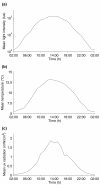Bumblebee foraging rhythms under the midnight sun measured with radiofrequency identification
- PMID: 20587015
- PMCID: PMC2907328
- DOI: 10.1186/1741-7007-8-93
Bumblebee foraging rhythms under the midnight sun measured with radiofrequency identification
Abstract
Background: In the permanent daylight conditions north of the Arctic circle, there is a unique opportunity for bumblebee foragers to maximise intake, and therefore colony growth, by remaining active during the entire available 24-h period. We tested the foraging rhythms of bumblebee (Bombus terrestris and B. pascuorum) colonies in northern Finland during the summer, when the sun stays above the horizon for weeks. We used fully automatic radio-frequency identification to monitor the foraging activity of more than 1,000 workers and analysed their circadian foraging rhythms.
Results: Foragers did not use the available 24-h foraging period but exhibited robust diurnal rhythms instead. A mean of 95.2% of the tested B. terrestris workers showed robust diurnal rhythms with a mean period of 23.8 h. Foraging activity took place mainly between 08:00 and 23:00, with only low or almost no activity during the rest of the day. Activity levels increased steadily during the morning, reached a maximum around midday and decreased again during late afternoon and early evening. Foraging patterns of native B. pascuorum followed the same temporal organisation, with the foraging activity being restricted to the period between 06:00 and 22:00.
Conclusions: The results of the present study indicate that the circadian clock of the foragers must have been entrained by some external cue, the most prominent being daily cycles in light intensity and temperature. Daily fluctuations in the spectral composition of light, especially in the UV range, could also be responsible for synchronising the circadian clock of the foragers under continuous daylight conditions.
Figures




References
-
- Benton T. Bumblebees. New York: HarperCollins; 2008.
-
- Goulson D. Bumblebees: Their Behaviour and Ecology. Oxford: Oxford University Press; 2003.
-
- Spaethe J, Weidenmüller A. Size variation and foraging rate in bumblebees (Bombus terrestris) Insect Soc. 2002;49:142–146. doi: 10.1007/s00040-002-8293-z. - DOI
-
- Stelzer RJ, Stanewsky R, Chittka L. Circadian rhythms of complete forager castes of bumblebee colonies monitored by radio-frequency identification. J Biol Rhythms. 2010. - PubMed
Publication types
MeSH terms
LinkOut - more resources
Full Text Sources

